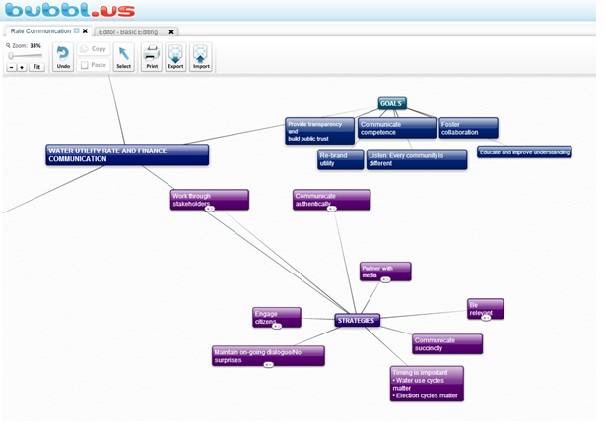Water utilities face trying times when communicating the need to increase rates to cover the increasing costs of operating water and wastewater utilities. The issues are complex. The public is constantly bombarded with news from their phones, TVs, computers, etc., and Board turnover can wipe-out years of institutional knowledge. Additionally, customers have a general distrust for water utilities. Perhaps it’s from a history of underpricing and a reluctance of water utilities to actively market themselves (i.e. the “silent service”). Or maybe customers see water rates as just another tax.
Whether a utility faces all or some of these obstacles, the requirement for effective communication regarding the financial need and value of high water quality is growing. Last month at the AWWA/WEF Utility Management Conference, six panelists and a room of actively-engage participants discussed communications strategies to help water utilities overcome these obstacles, re-brand the water utility, and build public trust.The list below summarizes the strategies discussed in the workshop and the proposed supporting rationale. The entire discussion was captured as a mind map available at: https://bubbl.us/view/1d6fdd/3cbb30/19rWcRIBIs3tw/.
Eight Communications Strategies to Help Water Utilities Get the Rates They Need
1. Communicate authentically (Bishop 2003)
It seems simple, but communicating with boards, stakeholders, and the public doesn’t require any magic tricks. Just authenticity. Authentic communication is defined as:
- Relevant
- Truthful
- Fundamental
- Comprehensive
- Accessible
- Responsive
- Compassionate
- Consistent
2. Partner with the media
The media can be a beneficial partner in utility communication, but it takes effort and consideration to develop and maintain the relationship. Utilities can help nurture this relationship by giving detailed context in down-times (e.g. facility tours) and by being responsive and even proactive when news hits. Also, it’s important to remember that the media is a business. Buying advertising can help get your message out there while also supporting the media.
3. Be relevant
Relevancy equals resonance. Typical topics of concern are affordability, utility cost efficiency, reliability, economic development, and the individual impacts of rate increases. Utilities should anticipate and proactively address these questions and others identified through engagement (see #5). Reliability is particularly important to customers. Comparisons are important to board members. And tools like the EFC’s rates and finance dashboards can help utilities make relevant comparisons.
4. Communicate succinctly
A message map that clearly identifies the relevant facts for an audience regarding a project can help keep communication on point and memorable. Generally speaking, messages that work contain only 27 words, take only 9 seconds to recount, and address only three points. Make your communication count. (Eg. “Water supply reliability at Karen’s Water Agency is at risk due to the need to upgrade the distribution system, new treatment needs, and increasing energy costs.”
5. Engage citizens/customers
There are a number of ways that utilities can engage citizens. The classic “water utility school program” is an important way to seed dinner-time conversations and build a long-term relationship with future customers. But citizen engagement can also be done much more directly through advisory committees. A representative advisory committee can be a great mechanism for listening and understanding for both the utility and its customers. And building a communication strategy based on the discussions of this committee can lend a great deal of credibility and relevancy (See #3) to a rate case. The panel at the Savannah proposed that advisory committees are most useful when they have a limited scope and structured forum. Utilities should let citizens volunteer for the committee (rather than by invitation) and, as painful as it may be, utilities should recruit the biggest detractors to the committee.
6. Work through stakeholders
In addition to citizens, engaging other stakeholders can help improve a utility’s rate case. Although stakeholders will vary by utility, they typically include environmentalists, neighboring utilities, large industries, elected officials (even if not a member of the utility’s governing board) etc. Stakeholders can serve as a champion for a utility and its projects and can lend credibility to the utility’s message.
7. Consider timing
Like it or not, external schedules will play a role in how customers and board members respond to a rate adjustment request. It will be important to take a step-back and consider the community context of a request for a water or wastewater increase. Elections are likely the most influential external event on the success of a rate case.
8. Maintain on-going dialogue
The days of a the “silent” water and wastewater service are behind us. A water utility governing board should not be surprised by a rate adjustment request, because they should be involved in stages of the process (planning, prioritizing, analyzing, and presenting). One method for ensuring consistent communication is through a series of small and frequent rate increases, which research shows will ultimately lead to higher cumulative increases (Hughes et al 2014). Five-year rate plans can help keep the conversation going, as well.
Co-authors/Workshop Panelists:
- Rick Giardina, Raftelis Financial Consultants, Inc.
- Jeff Hughes, Environmental Finance Center at UNC-Chapel Hill
- John Mastracchio, ARCADIS
- Karen Raucher, Stratus Consulting Inc.
- Bob Raucher, Stratus Consulting Inc.
- Marcela Navarrete, El Paso Water Utilities
- Rich Atwater, Southern California Water Committee
Slide decks from the workshop can be found at: http://www.efc.sog.unc.edu/event/awwawef-utility-management-conference-2014.
The workshop was conducted as part of the Water Research Foundation project on the “Rate Approval Process Communication Strategy and Toolkit.”
References
Bishop, B. 2003. Water utility communication practices – What contributes to success? Journal AWWA 95(1): 42-51.
Hughes, J., P. Brandt, M. Tiger, S. Eskaf & S. Berahzer. 2014. Defining a Resilient Business Model for Water Utilities. Water Research Foundation Report #4366.






0 Comments
1 Pingback